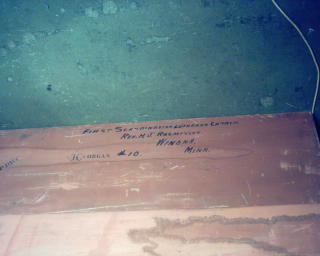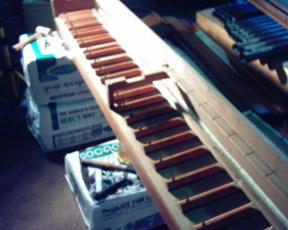Hello, we have just finished our annual "get your feet wet" tuning tour to the Arrowhead region of Minnesota. The leave were just prior to peak and a joy to look at. Lake Superior always fascinates me.
Now, off to North Dakota for a couple of weeks.....
Saturday, October 15, 2005
WOW! & Congratulations!
We at Ulm Orgelwerke want to congratulate our next door neighbor, Pat Fossum. For those that don't already know, Pat matched all five white balls in the October 12, 2005 Powerball Lotto drawing. She also had the Powerplay option, so she is South Dakota's newest millionaire!
She is also very camera shy, so I don't have a picture for you.
Congratulations Pat! Now about that $650,000 left over after taxes.......
Also, we will be away in the wilds of North Dakota for the rest of October, so postings may be a little sparse between now and then. If you are one of our regular customers, expect us on your church doorstep sometime between now and December 15th!
She is also very camera shy, so I don't have a picture for you.
Congratulations Pat! Now about that $650,000 left over after taxes.......
Also, we will be away in the wilds of North Dakota for the rest of October, so postings may be a little sparse between now and then. If you are one of our regular customers, expect us on your church doorstep sometime between now and December 15th!
Friday, October 07, 2005
Continuing Preparations
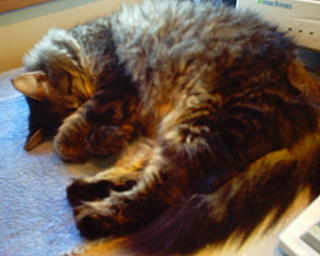
Hello all,
we are still making preparations for the start of tuning season on Monday, October 11. I am spending a lot of time in the office working on my computer. Because I am there, our VCU/CAT system has entered "sleep mode."
Here is a picture of the system as it often appears these days. Sleep mode conserves an emormous amount of energy...so we are glad to be able to save. Just one of the many ways we stretch your dollar here at Ulm Orgelwerke.
(P.S. if you think this is bad now, wait until December when I am totally washed out, then the jokes get REALLY bad!)
Tuesday, October 04, 2005
From the Vault.....
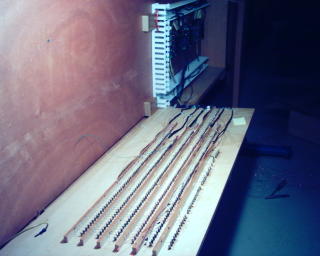
Hello Again,
Well, things in the shop are starting to calm down, but the office is starting to heat up. We are in preparation for the fall tuning season-which starts in five days, yikes!
Since I don't yet have any pictures of tuning, I decided to pull something from the archives.....
To the left is a shot of the relay and junctionboard of one of our instruments in NE SD. In the forground is the junction panel (backside) Each one of the little pins is then connected to a pipe valve in the windchest. In the darker area at the back is the actual relay. In this case, it is a microprocessor driven system (ie a computer) that "decodes" signals from a similar unit in the organ console about 30 feet away on the other side of the wall......
I hope to have some more pictures of tuning and also of our outstanding VCU/CAT system in a week or two.
Sunday, October 02, 2005
An Unfortunate Announcement
Hello to all.....
We are preparing for the fall tuning season....10-12 weeks of travel and around 150 organs to tune. This is also the time of year when we thoroughly tune the instruments.
Because of the extremely sudden rise in gasoline prices, we have been forced to add a 10% fuel surcharge to all of our fall tuning statements. This is not something that we want to do; however, we will face a loss if we do not.
Also, we are pleased to announce that another Kilgen organ is now available for purchase. One Manual, 6 Ranks. More information is available by contacting us directly.
Best wishes for the fall season.
We are preparing for the fall tuning season....10-12 weeks of travel and around 150 organs to tune. This is also the time of year when we thoroughly tune the instruments.
Because of the extremely sudden rise in gasoline prices, we have been forced to add a 10% fuel surcharge to all of our fall tuning statements. This is not something that we want to do; however, we will face a loss if we do not.
Also, we are pleased to announce that another Kilgen organ is now available for purchase. One Manual, 6 Ranks. More information is available by contacting us directly.
Best wishes for the fall season.
Wednesday, September 28, 2005
Hello Again
Hello all,
After nearly a month of working elsewhere, I am back in the shop getting ready for the fall tuning season.
Due to circumstances beyond our control, the organ that we have been reassembling this summer is for sale again. It is a six rank Kilgen. It would work for a small church or home installation. Installation is available and the price is negotiable, but somewhere in the $25,000 range.
Soon, there will be pictures of the work on the console rebuilding process for a Catholic Church in southern Minnesota. Thank you all for your patience this last month.
After nearly a month of working elsewhere, I am back in the shop getting ready for the fall tuning season.
Due to circumstances beyond our control, the organ that we have been reassembling this summer is for sale again. It is a six rank Kilgen. It would work for a small church or home installation. Installation is available and the price is negotiable, but somewhere in the $25,000 range.
Soon, there will be pictures of the work on the console rebuilding process for a Catholic Church in southern Minnesota. Thank you all for your patience this last month.
Monday, August 29, 2005
Data Security
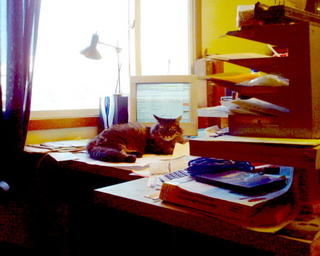
Hello all.....Just wanted to let you know that while Howard and I are off doing other things, the data you have entrusted to us is secure.....we have installed the new security system called CAT (Capture All Trespassers) This is what an intruder would see if they tried to get to the sensitive data stored on my computer. CAT is a new module attached to the VCU (Vermin Control Unit - see July postings) Ulm Orgelwerke is proud to be able to offer this service to our customers......
At any rate, we are off to Springfield, MN to secure an organ during a church construction project. We will be removing pipes to safe storage, sealing the swell chamber, great chest, and blower system from dust; and covering the facade of the instrument. There will be pictures this weekend.
Friday, August 12, 2005
Summer Diversions
Well, things are a bit slower here at UO now. The Stone Church Organ is at a stage where we will need some further input from the purchaser to proceed much further.
Howard will be in North Dakota doing some emergency repair work and delivering the console mentioned earlier.
I will be taking some time off to work for another company for few weeks also. I will still be posting regularly.
Howard will be in North Dakota doing some emergency repair work and delivering the console mentioned earlier.
I will be taking some time off to work for another company for few weeks also. I will still be posting regularly.
Monday, August 08, 2005
A Side Trip Completed
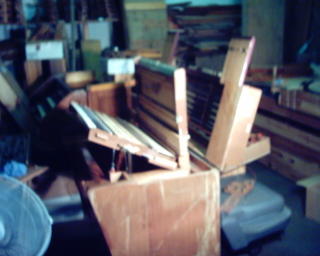 This is a picture of the entire console with the top and two keyboards in their extended positions. This way both sides of things are relatively accessible. "Relatively" is a relative term however. Whatever you need to get at will invariably be in the area right around the hinges or some other unaccessible place. The bottom keyboard folds and the top keyboard comes down and then the upper box locks them both in place. This arrangement, or some variation thereof, is the standard way that non-tracker organs are built today.
This is a picture of the entire console with the top and two keyboards in their extended positions. This way both sides of things are relatively accessible. "Relatively" is a relative term however. Whatever you need to get at will invariably be in the area right around the hinges or some other unaccessible place. The bottom keyboard folds and the top keyboard comes down and then the upper box locks them both in place. This arrangement, or some variation thereof, is the standard way that non-tracker organs are built today.
A Side Trip Continued......
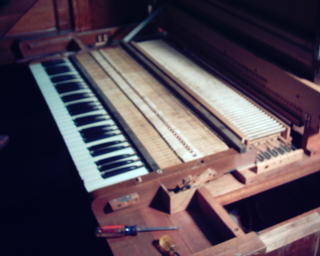 Whew! That was a disgusting job. Anyway, now the keyboard is clean and I can point out some details. As I said before, this is an electromechanical console. That means that both the organist's force and electricity are used to control the instrument. (As opposed to the all-organist or mechanical action of the Stone Church organ that we are working on.)
Whew! That was a disgusting job. Anyway, now the keyboard is clean and I can point out some details. As I said before, this is an electromechanical console. That means that both the organist's force and electricity are used to control the instrument. (As opposed to the all-organist or mechanical action of the Stone Church organ that we are working on.)The fulcrum of the keys is the red and black dots in the center. The return springs are just visible next to the metal bar at the back. Underneath the metal bar are little levers that the keys push up. That moves a contactor bar under the white area to touch one or more metal leads. If a circuit is completed, a note sounds, if not-well, it doesn't. There are one or two other things going on under the white bars, but without clear pictures it is impossible to really explain. Trust me, it works.
A Side Trip.....
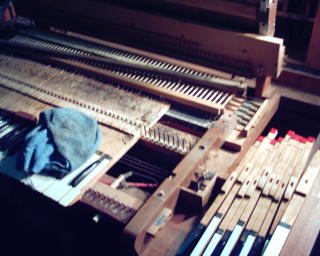
Hi there, today I spent the day working on a small project for a customer. They have purchased a "pre-owned" console for a organ project of their own. Unfortuneatly for me, the console had to be cleaned up before it left the shop. Above you can see what an electromechanical keyboard looks like. You can also see the results of some little living creatures who decided to move in during storage. While they have been evicted (VCU is active) it is still a mess.
Where?
Restoration Dilemmas
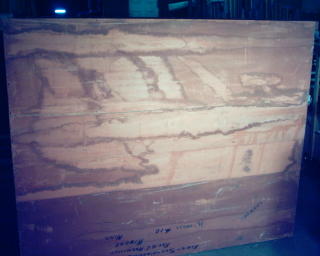
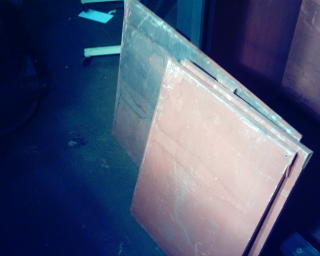
Hi there! Here is an example of the question: "How far do you go when 'restoring' something"? The two pictures here clearly show the damage that water has done to the swell case, so do I take water to "clean" it up? If not, do I leave it dirty?
In this case (no pun intended) I decided to take the lesser route. I have vacuumed off all of the oxidized paint and dirt that I can scrape with the vacuum brush and left whatever I couldn't remove.
The picture on the left is of the top of the swell case. There is clearly still about 30 years worth of dirt there, but to remove any more, I would have to use water. The picture on the right shows what water does to this paint. So, I guess I will say that the dirt is "historical" also.
Thursday, August 04, 2005
Chest Surgery - Part Last
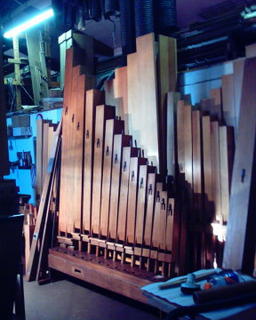
Here is what half the pipes look like on the pedal chest.
The little hole in the front is where the wind connects to the windchest. (For definitions, see the Monday, July 11 posting...after all, you are supposed to be learning something here!)
The hooks on the front will connect to a board down the center to keep the pipes on the straight and level.
The Pipe and I
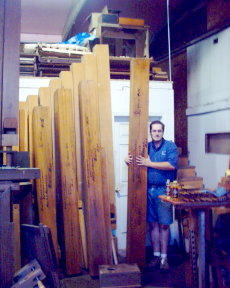
This is yours truly with the largest and lowest sounding pipe in the organ. It is the lowest "C" of the pedal Bourdon set. When playing, the air inside will be vibrating at about 32 cycles per second. Three of the next four pipes are leaning against the set of pipes on the wall.
For a sense of scale, I am about 6'5" in height.
Not really visible are the markings on each one. They are identical and read:
First Scandinavian Lutheran Church, Winona, MN
Yep, that is the church that originally bought the instrument in 1909-1910. If anyone out there can help us find some information about this congregation, email me at: organ2@iw.net
Chest Surgery - Part Third
Chest Surgery - Part Second

Howard is holding up one of the pallets. It is made of wood, felt, and leather. This is the number one reason we are always harping on keeping the wind clean. One small piece of sawdust will lodge in the felt and then the pallet can not seal completely. You now have air leaking wear it isn't supposed to be. This causes noise and irritation to anyone listening.
Once again, this chest is upside down. Normally, a pallet spring holds the pallet closed against gravity. Here the springs and rail have been removed for cleaning.
Cue next slide......
Chest Surgery - Part First
A Real Sticking Point
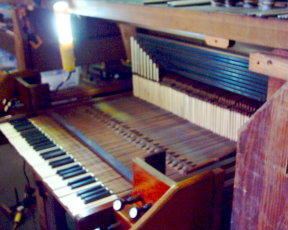
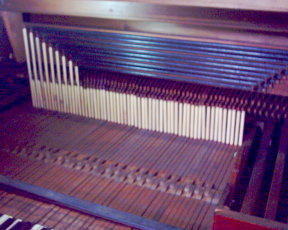
Ok, so it was a bad joke, I'm an organbuilder-it is part of the job description.......
The picture at left shows the relationship of the keys to the stickers. You press a key, the sticker moves up, presses one end of the rocker arm up and the other moves down, and pulls the pallet down admitting wind to the pipe.
The picture at right shows a bit more of the stickers themselves. They are nothing but wooden dowels with tiny rods drilled into them. We add a red felt washer for noise control and a little bit of wear reduction.
In both pictures the rollerboard is evident. For reasons of space and centering, it is desirable to split the bottom octave of pipes into two sections. Unfortunately, most musicians insist on having sequential note orders, so some way has to be found to move the motion to the opposite side....enter the rollerboard. Here, every other key connects to one end of the rollerboard, just visible at the opposite end is the connection to the proper rocker arm. It is the same process with a horizontal shift. (aye, organists are shifty folk.......)
(No, I have not yet cleaned the keys themselves, that is much later......)
Some more definitions:
Rollerboard: A device that uses rollers to move the physical force from the trackers in a horizontal orienation.
Rocker Arm: A device to move the physical force from the keys along a horizontal plane.
Sticker: A vertical tracker. Usually used when the distance travelled is less than 6 inches.
Pedals Part Four....
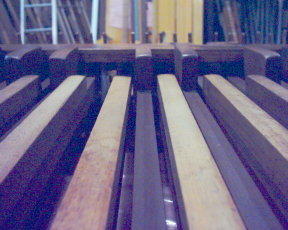

After much Murphy Soap, Lemon Oil, Bees Wax, and Graphite the pedalboard is back together and looking new.
In the picture on the left you can just see the newly leathered pin near the top center. The variantions in color that are visible on the pedals illustrate one of the problems of restoration: how far do you go? While I could have removed all the dirt from the pedals, I would have probably taken the finish with it. So, to save some authenticity, I have used the same process for each pedal and just left it that way.
In the picture on the right the pedal board and first pedal square rail have been positioned in the approximate relationship to each other. When fully assembled, the squares will connect to the pedals with a short sticker. They will also connect to the second square rail at the back of the instrument from the top. The resulting action will be that the pedal is pressed down, the square will pull on the tracker, the correct square on the second square rail will be pulled forward, the square will pull the pallet down, and hopefully a reasonably musical sound will come from the pipe.
For those that missed them, here are some definitions:
Square: A wood or metal device that changes the orientation of the physical energy carried by trackers.
Square Rail: A frame that holds a number of squares in the proper position.
Pallet: the supports and sealing surface of the device that blocks or allows air to the pipes.
Tracker: the physical device (usually a long thin piece of wood) that connects the key to the pallet.
Subscribe to:
Posts (Atom)
